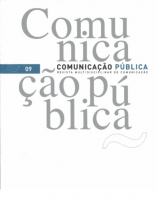Reflexions on the possible concept of minority radio
DOI:
https://doi.org/10.4000/cp.7647Keywords:
minority media, migration, ethnicity, diaspora, radioAbstract
This theoretical exercise explores the drawbacks of terms used in the literature to designate media intiatives made by, with, for and/or about migrants and minorities, such as «ethnic minority media» (Riggins 1992) and «diasporic media» (Tsagarousianou 2004; Georgiou 2003). Motivated by the need to find a sufficiently open, and yet operational, way of naming a research project’s object of study, radio programs, it builds on ideas related to media that supplement channels of mass-communication with alternatives deemed secondary (Online/More Color in the Media 2004; Dayan 1998; Sreberny-Mohammadi and Mohammadi 1994), to propose the notion of «minority radio» as a potentially suitable mid-range concept (Merton 1968).
Downloads
References
Anthias, F. (1998) Evaluating ‘diaspora’: beyond ethnicity? Sociology, 32 (3), pp. 557-580.
Baumann, G. (1996) Contesting Culture – Discourses of Identity in Multi-Ethnic London. Cambridge/Nova Iorque/Melbourne/Madrid, Cambridge University Press.
Appadurai, A. (1991) Global ethnoscapes: notes and queeries for a transnational anthropology. In Fox, R. ed. Recapturing Anthropology – Working in the present. Santa Fe, School of American Advanced Research Press, pp. 191-211.
Clifford, J. (1997) Diasporas. In Clifford, J. Routes – Travel and Translation in the Late Twentieth Century. Cambridge, Harvard University Press, pp. 244-277. DOI : 10.1525/can.1994.9.3.02a00040 good / bad
Dayan, D. (1998) Particularistic media and diasporic communications. In Liebes, T. e Curran, J. eds. Media, Ritual and Identity. Londres/Nova Iorque, Routledge, pp. 103-114.
Georgiou, M. (2003) Mapping Diasporic Communities and their Media – Studying the Media, Investigating Inclusion and Participation in European Societies, European and Transnational Communities. [Internet] Disponível em http://www.lse.ac.uk/collections/EMTEL/Minorities/minorities_docs.html [consult. 18 de Julho de 2009].
Gillespie, M. (1995) Television, Ethnicity and Cultural Change. London, Routledge. DOI : 10.4324/9780203133996 good / bad
Gilroy, P. (2003) The Black Atlantic as a counterculture of modernity. In Braziel, J. E. e Mannur, A. eds. Theorizing Diaspora – A Reader. Malden/Oxford/Melbourne/Berlin, Blackwell Publishing, pp. 49-81.
Ginsburg, F. (1997) From little things, big things grow: Indigenous media and cultural activism. In Fox, R. e Stam, O. eds. Between Resistance and Revolution. Cultural Politics and Social Protest. New Brunswick/Londres/New Jersey, Rutgers University Press, pp. 118-144.
Ginsburg, F. (1991) Indigenous media: Faustian contract or global village? Cultural Anthropology, 6 (1), pp. 92-112. DOI : 10.1525/can.1991.6.1.02a00040 good / bad
Hall, S. (2003) Cultural identity and diaspora. In Braziel, J. E. e Mannur, A. eds. Theorizing Diaspora – A Reader. Malden/Oxford/Melbourne/Berlin, Blackwell Publishing, pp. 233-247.
Hendy, D. (2000) Radio in the Global Age. Malden, Blackwell.
Husband, C. (2005) Minority ethnic media as communities of practice: professionalism and identity politics in interaction. Journal of Ethnic and Migration Studies, 31 (3), p. 461-479. DOI : 10.1080/13691830500058802 good / bad
Marcus, G. (1995) Ethnography in/of the world system: The emergence of multi-sited ethnography. Annual Review of Anthropology, 24, pp. 95-117. DOI : 10.1146/annurev.an.24.100195.000523 good / bad
Merton, R. K. (1968) Social Theory and Social Structure. Londres, Collier and MacMillan.
Morley, D. (2000) Home Territories: Media, Mobility and Identity. Londres, Routledge.
Napoli, M. (2002) Audience valuation and minority media: an analysis of the determinants of the value of radio audiences. Journal of Broadcasting & Electronic Media, 46 (2), pp. 169-184. DOI : 10.1207/s15506878jobem4602_1 good / bad
Online/More Color in the Media (2004) A European manifesto to support and to underline the importance of minority community media. [Internet] Disponível em http://www.multicultural.net/ /manifesto/index.htm [Consult. 8 de Agosto de 2008].
Riggins, S. H. (1992) The media imperative: ethnic minority survival in the age of communication. In Riggins, S. H. ed. Ethnic Minority Media – An International Perspective, pp. 1-20.
Roosens, E. (1989) Creating ethnicity: the process of ethnogenesis, Frontiers of Anthropology, 5, Londres/Newbury Park/Nova Deli, Sage.
Silverstone, R. e Georgiou, M. (2005) Diasporic media across Europe: Multicultural societies and the universalism/particularism continuum. Journal of Ethnic and Migration Studies, 31 (3), pp. 481-498.
Spyer, P., Van Heeren, K. e Sushartami, W. (2002) Indonesian mediations: The re-imagining and re-imaging of community(’s) in transition – a position paper. In Nordholt, H. S e Abdullah, I. eds, Indonesia: In Search of Transition. Yogyakarta, Pustaka Pelajar, pp. 177-206.
Spitulnik, D. (1993) Anthropology and mass media. Annual Review of Anthropology, 22, pp. 293-315.
Sreberny-Mohammadi, A. e Mohammadi, A. (1994) Small Media, Big Revolution – Communication, Culture and the Iranian Revolution. Minneapolis/Londres, University of Minnesota Press.
Tacchi, J. (2002) Radio texture: between self and others. In Askew, K. & Wilk, R. eds. The Anthropology of Media: a Reader. Londres, Blackwell. pp. 241-257.
Tsagarousianou, R. (2004) Rethinking the concept of diaspora – Mobility, connectivity and communication in a globalized world. Westminster Papers in Communication and Culture. Vol. 1 (1), pp. 52-65.
Vertovec, S. (1999) Three meanings of ‘diaspora’, exemplified through South Asian religions. Diaspora 7 (2), p.p. 1-37. [Internet] Disponível em http://www.transcomm.ox.ac.uk/working%20papers/diaspora.pdf [Consult. 28 Abril 2009].
Downloads
Published
Issue
Section
License
Copyright (c) 2010 Direitos de Autor (c) 2010

This work is licensed under a Creative Commons Attribution-NonCommercial 4.0 International License.
Os conteúdos da Comunicação Pública estão licenciados com uma licença Creative Commons - Atribuição-NãoComercial 4.0 Internacional.


